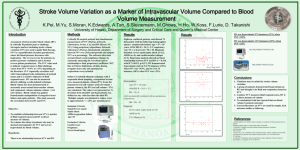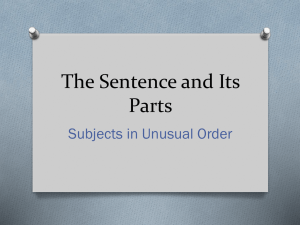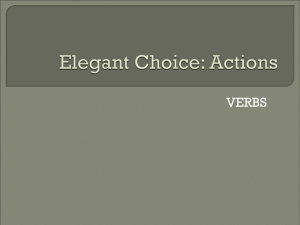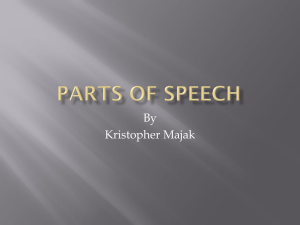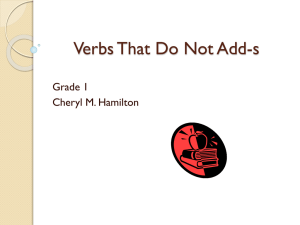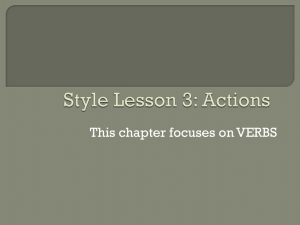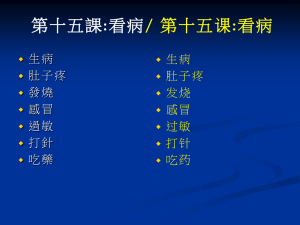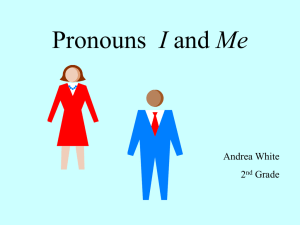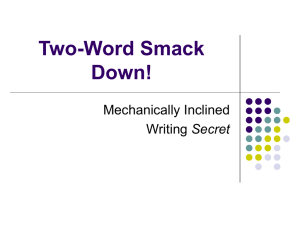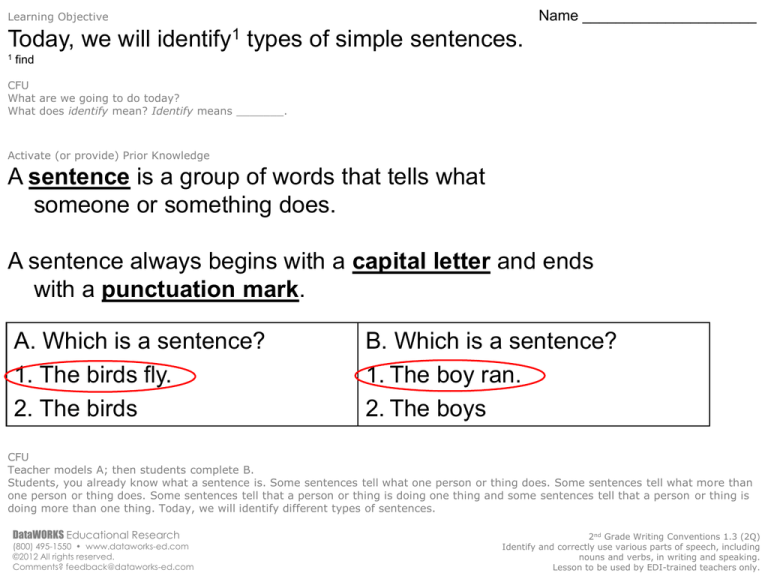
Name _____________________
Learning Objective
Today, we will identify1 types of simple sentences.
1
find
CFU
What are we going to do today?
What does identify mean? Identify means _______.
Activate (or provide) Prior Knowledge
A sentence is a group of words that tells what
someone or something does.
A sentence always begins with a capital letter and ends
with a punctuation mark.
A. Which is a sentence?
1. The birds fly.
2. The birds
B. Which is a sentence?
1. The boy ran.
2. The boys
CFU
Teacher models A; then students complete B.
Students, you already know what a sentence is. Some sentences tell what one person or thing does. Some sentences tell what more than
one person or thing does. Some sentences tell that a person or thing is doing one thing and some sentences tell that a person or thing is
doing more than one thing. Today, we will identify different types of sentences.
DataWORKS Educational Research
(800) 495-1550 • www.dataworks-ed.com
©2012 All rights reserved.
Comments? feedback@dataworks-ed.com
2nd Grade Writing Conventions 1.3 (2Q)
Identify and correctly use various parts of speech, including
nouns and verbs, in writing and speaking.
Lesson to be used by EDI-trained teachers only.
Concept Development
A sentence always has a subject (S) and a verb (V).
• The verb is the word that tells what the action is.
Examples: walk, run, play,
• The subject is the word that names who does the action.
Examples: teacher, boy, girl, bird, dog, Mary
● The subject of a sentence is usually a noun.
• Sentences can have more than one verb (SVV) and more than one subject (SSV).
Examples:
SV
SSV
SVV
Birds soar.
Birds and insects fly.
Birds soar and fly.
Not an example of a sentence:
(S)
The birds
(V)
fly high
CFU
What two parts could you look for to help you identify a sentence?
Why is “fly high” not an example of a sentence?
Which sentence has two verbs? Explain your answer.
a. Joe reads and writes.
b. Joe reads.
Who is the subject in both sentences? How do you know?
In your own words, what is a verb? A verb is ____________________________.
In your own words, what is a subject? A subject is _______________________.
DataWORKS Educational Research
(800) 495-1550 • www.dataworks-ed.com
©2012 All rights reserved.
Comments? feedback@dataworks-ed.com
2nd Grade Writing Conventions 1.3 (2Q)
Identify and correctly use various parts of speech, including
nouns and verbs, in writing and speaking.
Lesson to be used by EDI-trained teachers only.
Skill Development/Guided Practice
A sentence always has a subject (S) and a verb (V).
•
The verb is the word that tells what the action is.
•
The subject is the word that names who does the action.
Identify types of simple sentences.
Step #1: Read the sentence carefully.
Step #2: Label the “action” or the verb(s) “V.”
Step #3: Label the “who” or the subject(s) “S.”
Step #4: Identify the type of sentence it is: SV, SSV, or SVV. (circle)
Type of Sentence
1.
2.
3.
4.
5.
6.
7.
8.
9.
S
V
The tiger roars.
S
V
Timmy blows bubbles.
S
V
Lizards run fast.
S
S
V
Mice and hamsters eat pellets.
S
S
V
Cows and horses eat hay.
S
S V
Tom and Dave ride bikes everyday.
V
S V
The dog runs and barks.
V
V
S
Johnny sleeps and dreams.
V
S
V
Suzie runs and walks.
SV
SSV
SVV
SV
SSV
SVV
SV
SSV
SVV
SV
SSV
SVV
SV
SSV
SVV
SV
SSV
SVV
SV
SSV
SVV
SV
SSV
SVV
SV
SSV
SVV
CFU
How did I identify the verb? How did I identify the subject? How did I identify the sentence type? How did you identify the verb? How did
you identify the subject? How did you identify the sentence type? What is the difference between SSV and SVV sentences?
DataWORKS Educational Research
(800) 495-1550 • www.dataworks-ed.com
©2012 All rights reserved.
Comments? feedback@dataworks-ed.com
2nd Grade Writing Conventions 1.3 (2Q)
Identify and correctly use various parts of speech, including
nouns and verbs, in writing and speaking.
Lesson to be used by EDI-trained teachers only.
Relevance
A sentence always has a subject (S) and a verb (V).
• The verb is the word that tells what the action is.
• The subject is the word that names who does the action.
1. Identifying simple sentences helps you combine sentences.
2
put together
Jerry walked to school. Lucille walked to school.
Jerry and Lucille walked to school.
2. Identifying simple sentences will help you do well on tests.
CFU
Does anyone else have a reason why it is relevant to identify types of simple sentences? (pair-share) Why is it relevant to identify types of
simple sentences? You may give me one of my reasons or one of your own. Which reason is more relavant to you? Why?
DataWORKS Educational Research
(800) 495-1550 • www.dataworks-ed.com
©2012 All rights reserved.
Comments? feedback@dataworks-ed.com
2nd Grade Writing Conventions 1.3 (2Q)
Identify and correctly use various parts of speech, including
nouns and verbs, in writing and speaking.
Lesson to be used by EDI-trained teachers only.
A sentence always has a subject (S) and a verb (V).
•
The verb is the word that tells what the action is.
•
The subject is the word that names who does the action.
Skill Closure
Identify types of simple sentences.
Step #1: Read the sentence carefully.
Step #2: Label the “action” or the verb(s) “V.”
Step #3: Label the “who” or the subject(s) “S.”
Step #4: Identify the type of sentence it is: SV, SSV, or SVV. (circle)
1.
2.
3.
S
V
Trish plays soccer.
S
S V
The bird and the boy sing.
S V
V
The cat runs and plays.
Type of Sentence
SV
SSV
SVV
SV
SSV
SVV
SV
SSV
SVV
Concept Closure
David says, “Paul and Sara laugh,” is a sentence. Is David correct? How do you
know?
Summary Closure
What did you learn today about identifying types of simple sentences? (pair-share)
DataWORKS Educational Research
(800) 495-1550 • www.dataworks-ed.com
©2012 All rights reserved.
Comments? feedback@dataworks-ed.com
2nd Grade Writing Conventions 1.3 (2Q)
Identify and correctly use various parts of speech, including
nouns and verbs, in writing and speaking.
Lesson to be used by EDI-trained teachers only.
Independent Practice
Name ____________________
A sentence always has a subject (S) and a verb (V).
• The verb is the word that tells what the action is.
• The subject is the word that names who does the action.
Identify types of simple sentences.
Step #1: Read the sentence carefully.
Step #2: Label the “action” or the verb(s) “V.”
Step #3: Label the “who” or the subject(s) “S.”
Step #4: Identify the type of sentence it is: SV, SSV, or SVV. (circle)
Type of Sentence
1.
2.
3.
4.
5.
6.
7.
8.
S
V
Tommy plays basketball.
V
S
The baby smiles.
V
S
Sara chews gum.
S
S
V
My brothers and sisters play games.
S
S
V
Mommy and Daddy hug.
S
S
V
Traci and Trish exercise everyday.
S
V
V
My friend jumps and runs.
S
V
V
Her sister dances and sings.
DataWORKS Educational Research
(800) 495-1550 • www.dataworks-ed.com
©2012 All rights reserved.
Comments? feedback@dataworks-ed.com
SV
SSV
SVV
SV
SSV
SVV
SV
SSV
SVV
SV
SSV
SVV
SV
SSV
SVV
SV
SSV
SVV
SV
SSV
SVV
SV
SSV
SVV
2nd Grade Writing Conventions 1.3 (2Q)
Identify and correctly use various parts of speech, including
nouns and verbs, in writing and speaking.
Lesson to be used by EDI-trained teachers only.
Periodic Review 1
Name ____________________
A sentence always has a subject (S) and a verb (V).
•
The verb is the word that tells what the action is.
•
The subject is the word that names who does the action.
Identify types of simple sentences.
Step #1: Read the sentence carefully.
Step #2: Label the “action” or the verb(s) “V.”
Step #3: Label the “who” or the subject(s) “S.”
Step #4: Identify the type of sentence it is: SV, SSV, or SVV. (circle)
Type of Sentence
1.
2.
3.
4.
5.
6.
7.
8.
V
S
V
The bees buzz and fly in the spring.
S V
V
Jim reads and studies for his exam.
S V
S
The boy and the girl play baseball.
V
S
Jorge fell off his bike.
S V
Joan eats vegetables and fruits
every day.
S
V
Susie sings in the shower.
S V
V
The boy sang and danced at the party.
S
V
S
Monkeys and gorillas climb trees.
DataWORKS Educational Research
(800) 495-1550 • www.dataworks-ed.com
©2012 All rights reserved.
Comments? feedback@dataworks-ed.com
SV
SSV
SVV
SV
SSV
SVV
SV
SSV
SVV
SV
SSV
SVV
SV
SSV
SVV
SV
SSV
SVV
SV
SSV
SVV
SV
SSV
SVV
2nd Grade Writing Conventions 1.3 (2Q)
Identify and correctly use various parts of speech, including
nouns and verbs, in writing and speaking.
Lesson to be used by EDI-trained teachers only.
Name____________________
Periodic Review 2
A sentence always has a subject (S) and a verb (V).
• The verb is the word that tells what the action is.
• The subject is the word that names who does the action.
Identify types of simple sentences.
Step #1: Read the sentence carefully.
Step #2: Label the “action” or the verb(s) “V.”
Step #3: Label the “who” or the subject(s) “S.”
Step #4: Identify the type of sentence it is: SV, SSV, or SVV. (circle)
1.
2.
3.
4.
5.
6.
7.
8.
S V
V
I climbed and fell off the tree.
S
V
The baby cried.
V
V
S
The lion growls and roars.
S V
Birds fly.
S
V
V
The boy jumped and fell off the bed.
S
S V
Susie and Jake talk a lot.
S
V
S
Nate and Wong play football.
V
S
The puppy likes to run outside.
DataWORKS Educational Research
(800) 495-1550 • www.dataworks-ed.com
©2012 All rights reserved.
Comments? feedback@dataworks-ed.com
Type of Sentence
SV
SSV
SVV
SV
SSV
SVV
SV
SSV
SVV
SV
SSV
SVV
SV
SSV
SVV
SV
SSV
SVV
SV
SSV
SVV
SV
SSV
SVV
2nd Grade Writing Conventions 1.3 (2Q)
Identify and correctly use various parts of speech, including
nouns and verbs, in writing and speaking.
Lesson to be used by EDI-trained teachers only.
Name____________________
Periodic Review 3
A sentence always has a subject (S) and a verb (V).
•
The verb is the word that tells what the action is.
• The subject is the word that names who does the action.
Identify types of simple sentences.
Step #1: Read the sentence carefully.
Step #2: Label the “action” or the verb(s) “V.”
Step #3: Label the “who” or the subject(s) “S.”
Step #4: Identify the type of sentence it is: SV, SSV, or SVV. (circle)
Type of Sentence
S
V
V
1.
Mrs. Garcia wrote and sent a letter to
camp.
2.
The girls smiled for the camera.
3.
Billy and Jane walked the dog.
4.
The girls and boys sing in the choir.
5.
Birds sing and fly.
S
V
S
S
V
S
S
V
V
S
S
V
V
V
6.
The baby fussed and cried.
7.
She is beautiful.
8.
S V
S
V
V
We ran and played tag.
DataWORKS Educational Research
(800) 495-1550 • www.dataworks-ed.com
©2012 All rights reserved.
Comments? feedback@dataworks-ed.com
SV
SSV
SVV
SV
SSV
SVV
SV
SSV
SVV
SV
SSV
SVV
SV
SSV
SVV
SV
SSV
SVV
SV
SSV
SVV
SV
SSV
SVV
2nd Grade Writing Conventions 1.3 (2Q)
Identify and correctly use various parts of speech, including
nouns and verbs, in writing and speaking.
Lesson to be used by EDI-trained teachers only.
Blank Page
DataWORKS Educational Research
(800) 495-1550 • www.dataworks-ed.com
©2012 All rights reserved.
Comments? feedback@dataworks-ed.com
2nd Grade Writing Conventions 1.3 (2Q)
Identify and correctly use various parts of speech, including
nouns and verbs, in writing and speaking.
Lesson to be used by EDI-trained teachers only.

